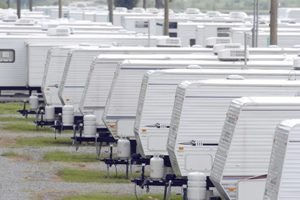
Is Toxic FEMA Trailers Making More Life Miserable for Survivors?. Formaldehyde-laced travel trailers, the same trailers that made life even more miserable for survivors of hurricanes Katrina and Rita, have shown up along the Gulf Coast again. This time, they are being used to house people working to clean up the BP oil spill. […]

Is Toxic FEMA Trailers Making More Life Miserable for Survivors?. Formaldehyde-laced travel trailers, the same trailers that made life even more miserable for survivors of hurricanes Katrina and Rita, have shown up along the Gulf Coast again. This time, they are being used to house people working to clean up the BP oil spill.
The problems with the travel trailers first surfaced when the Federal Emergency Management Agency (FEMA) distributed 120,000 of them in the wake of Katrina and Rita. By 2006 the agency was getting reports from field workers along the Gulf Coast that residents of FEMA trailers where getting sick from the air in the toxic trailers. The first suspect was formaldehyde, an invisible gas that is known to cause cancer. It can also cause other illnesses ranging from nose bleeds to chronic bronchitis. Commonly used in manufactured homes, formaldehyde can cause respiratory problems and has been classified as a carcinogen by the International Agency for Research on Cancer and as a probable carcinogen by the Environmental Protection Agency.
In late 2007, FEMA and the Centers for Disease Control (CDC) finally conducted air quality tests of 519 trailers. The CDC tests confirmed that the FEMA trailers posed a serious danger to residents still living in them. The average formaldehyde levels found in the toxic trailers measured 77ppb (parts per billions), significantly higher than the 10 to 17 ppb concentration seen in newer homes. When it announced its findings, the CDC urged FEMA to move residents from the toxic trailers as quickly as possible, with priority given to families with children, elderly people or anyone with asthma or other chronic conditions.
The government ended up banning such trailers from ever being used for long-term housing again. Not wanting to pay storage costs for the unwanted trailers, it then started selling them. More than 100,000 trailers have been sold so far in public auctions, and many have gone to businesses and individuals in Louisiana.
Despite the sales, the government says the trailers are not supposed to be used as temporary housing. A FEMA official told The New York Times that: “Subsequent owners must continue to similarly inform subsequent buyers for the life of the unit.”
But now the toxic trailers have new life, as thousands of oil spill clean up workers look for temporary housing along the Gulf Coast. One owner of a disaster contracting firm recently told The New York Times that he sold more than 20 of the trailers to cleanup workers and the companies that employ them in Venice and Grand Isle, La.
Most of the workers in the Gulf are not living in the trailers but in newer quarters provided by BP, but many others have purchased trailers so that they can stay with their wives and children after work. Dozens of companies contracted to do clean up work have also purchased trailers to house workers.
The trailers are commanding prices of $2,500 and up, the Times said.
In many cases, sellers are not bothering to inform prospective owners about the trailers’ risks. Officials with the inspector general’s office of the General Services Administration announced yesterday that they have opened at least seven cases concerning buyers who might not have posted the required certification and formaldehyde warnings on trailers they sold, the Times said.
The personal injury attorneys at Parker Waichman LLP offer free, no-obligation case evaluations. For more information, fill out our online contact form or call 1-800-YOURLAWYER (1-800-968-7529).


